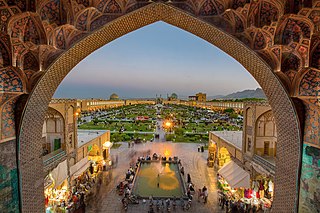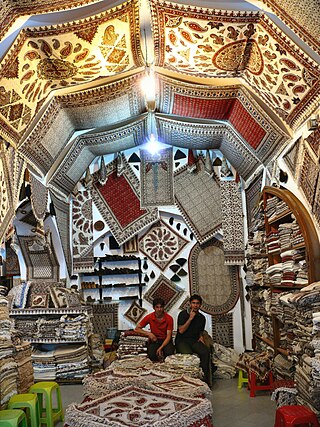
Isfahan, from its ancient designation Aspadana and, later, Spahan in middle Persian, rendered in English as Ispahan, is a major city in the Greater Isfahan Region, Isfahan Province, Iran. It is located 439.78 kilometres south of Tehran and is the capital of Isfahan Province. The city has a population of approximately 2,220,000, making it the third-largest city in Iran, after Tehran and Mashhad, and the second-largest metropolitan area.

Naqsh-e Jahan Square, also known as the Shah Square prior to 1979, is a square situated at the center of Isfahan, Iran. Constructed between 1598 and 1629, it is now an important historical site, and one of UNESCO's World Heritage Sites. It is 160 metres (520 ft) wide by 560 metres (1,840 ft) long. It is also referred to as Shah Square or Imam Square. The square is surrounded by buildings from the Safavid era. The Shah Mosque is situated on the south side of this square. On the west side is the Ali Qapu Palace. Sheikh Lotf Allah Mosque is situated on the eastern side of this square and at the northern side Qeysarie Gate opens into the Isfahan Grand Bazaar. Today, Namaaz-e Jom'eh is held in the Shah Mosque.

Falavarjan County is located in Isfahan province, Iran. The capital of the county is Falavarjan. At the 2006 census, the county's population was 232,019, in 60,613 households. At the 2016 census, the county's population was 249,814, in 77,213 households.

The Jāmeh Mosque of Isfahān or Jāme' Mosque of Isfahān, also known as the Atiq Mosque and the Friday Mosque of Isfahān, is a historic congregational mosque (Jāmeh) of Isfahan, Iran. The mosque is the result of continual construction, reconstruction, additions and renovations on the site from around 771 to the end of the 20th century. The Grand Bazaar of Isfahan can be found towards the southwest wing of the mosque. It has been a UNESCO World Heritage Site since 2012. It is one of the largest and most important monuments of Islamic architecture in Iran.

The "Esfahani" or "Isfahani style" is a style of architecture defined by Mohammad Karim Pirnia when categorizing Iranian architecture development in history. Landmarks of this style span through the Safavid, Afsharid, Zand, and Qajar dynasties starting from the 16th century to the early 20th century.

The Grand Bazaar is a historical market located in Isfahan, Iran, also known as the Qeysarriyeh Bazaar, Qeysarie bazaar or Soltani bazaar. The main commercial activities in the Qeysarie bazaar are carpet and kilim selling.
The Agha Nour mosque is a mosque located in Isfahan, Iran. It was founded during the Shah Abbas I era and completed during the Shah Safi era, and as such the names of both kings were mentioned in the inscription above the portal of the mosque. The mosque was built under the supervision of Noureddin Mohammad Esfahani, who was one of the richest men in Isfahan. The Shabestan of this mosque is one of the most beautiful Shabestans in Isfahan. This Shabestan has stone pillars with marble arches, which provide light during the day.
Ilchi mosque is a historical mosque in Isfahan, Iran. The founder of this small and simple mosque was Saheb Soltan Beigom, the daughter of a courtier in the Shah Suleiman's court. The word Ilchi (elçi) means messenger in Azeri. The mosque was built in 1686 under the supervision of Mohammad Ali ben Ostad ALibeyk.

Roknolmolk Mosque is a historical mosque in Isfahan. This mosque has been built in Qajar era and is close to Takht-e Foulad. It was built by Mirza Soleyman Khan Shirazi "Roknolmolk", who was a prominent personage in Isfahan. The Portal of the mosque has been decorated with the Roknolmolk's paintings and poems.

Mohammad Jafar Abadei Mosque is a historical mosque in Isfahan, Iran. It was built in 1878 by the famous clergyman of the Qajar era, Mohammad Jafar Abadei. The mosque is famous because of its tiles and its architecture.

Rahim Khan Mosque is a historical mosque in Isfahan, Iran. It was built in the late 19th century. This mosque has an unusual combination of styles in architectural decorations. The shabestan of this mosque is one of the biggest shabestans in Isfahan. The shabestan, portal, iwan and outer surface of the mosque's dome have been rebuilt.

The Barsian mosque and minaret are historical structures in the Isfahan province. Barsian, which was originally Parsian in the past, is a village located 42 km east of Isfahan. According to the inscriptions the mosque was built in 1105 and the minaret was built in 1098 in the era of Barkiyaruq, the Seljuq king. The minaret is the fourth old minaret in Iran, which has an inscription. It is 34 m high. Its bottom part has simple bricks, but the upper parts have been decorated by decorative bricks.

The Hafshuye Mosque is a historical mosque in the Isfahan province, Iran. It dates back to the seljukid era. The main part of the mosque, especially its dome, has been destroyed and its wall has been damaged. The structure has been built mainly with adobes, but its facade has been worked with bricks.

The Jalali Castle is located in Kashan, Iran.

The Chehel Dokhtaran mausoleum is a historical structure in Kashan, Iran. It is located to the west of Emamzadeh Soltan Mir Ahmad. The mausoleum was built in the Ilkhanid era. Its high simple unadorned dome is the hallmark of the architecture in the Ilkhanid era.
The Khaje Taj od-Din mausoleum is a historical structure in Kashan, Iran. In the 15th century, Khaje Taj od-Din, the brother of founder of Zeyn od-Din minaret, Khaje Zeyn od-Din, built a mosque with minarets and a school on the tombs of two Imamzadehs and some of his contemporary scientists and judges. In the course of time the mosque and minarets and school were destroyed and only two domes remained, which is named Khaje Taj od-Din mausoleum. The outer surface of its eastern dome has tile mosaic. Around the dome, it has been decorated with three rows of raised stucco inscriptions. The inscriptions are some poems in the Naskh and Thuluth scripts.

The Gouged stronghold is located in the city of Gouged, in the Golpayegan county, in Iran. The city Gouged is located 5 km to the north of Golpayegan. In peacetime, the stronghold was used as a caravansary, but during the war time or when the bandits attacked, it was used as a castle. This structure is located in the Golpayegani alley and Ghale alley. At present, the stronghold is used as a traditional three star hotel.

The Mesri Mosque is a historical mosque in Isfahan, Iran. The mosque was built in 1650 in the Safavid era. There is an inscription in its mihrab, written by the famous calligrapher Mohammad Reza Emami in Nastaliq script.
The Safa Mosque is a historical mosque in Isfahan, Iran. The mosque was built by Mohammad Golestaneh in the Qajar era and is located near the Shahshahan mausoleum.

The following is a timeline of the history of the city of Isfahan, Iran.















